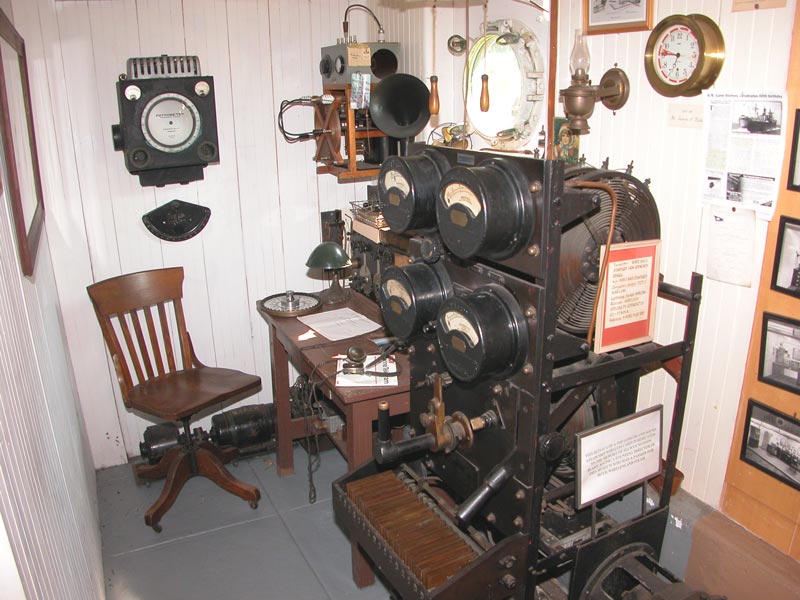Perhaps it will be important to comment about things that the Titanic disaster generated. After the Titanic disaster, governments suddenly decided to pass international laws, which, among other things, required two 3-minute sectors on the radio room clock, marked in red, where it became illegal to transmit unless you were in distress. They also required an emergency lamp in the radio room, and, naturally, being on a ship, it had to be in gimbals.
They also required an antenna disconnect switch. Many of the receivers were nothing more than crystal sets with a cat whisker on galena, which were quite sensitive to static discharge. When the operator saw a storm on the horizon, he was supposed to ground his antenna. Then, when the storm goes by, he could reconnect the antenna.
Transmission was always simplex, that is, you transmitted for a period, and then you stopped, and you received for a period, listening for the reply. And the transmit/receive switch is this one on the operating table. Right now it is in the transmit position, but when it’s down it’s in the receive position.
The peculiar thing about the quenched-gap spark transmitter is that there are many sparks, which you don’t see. They’re out of sight, but the quenched gap makes a very clean signal. That’s the spark electrode, and the corresponding face on the next one is the other spark electrode, so it sparks between this and the one next to it, all the way down the line.
The receiver is a classic IP-501-A, made by the Wireless Specialty Apparatus Company of Boston, Massachusetts, the building of which still stands on the East side of the main railroad line entering Boston from the South.
The 501-A is a 3-tube receiver. The tubes are in this compartment, and it can be used either on crystal or tube. Throwing this switch will change it from tube to crystal. The crystal is mounted on a separate board.
To the left is an emergency spark transmitter, this little job up here. It was made by the Standard Communications Company of Denmark, and we were lucky to find it on the Danish bark, Denmark. When the tall ships came to Providence, I toured the Denmark and saw this in the Captain’s cabin, all broken and rather sad looking. I happened to meet a Danish engineer in New York about six months later, and I told him about it, and he went back to Denmark, and somehow he got in touch with everybody, and had this sent back to the company which made it. They rebuilt it completely and they sent it back to us as a gift. This is our backup transmitter.
In radio history, Reginald A. Fessenden is an important name. Also in marine history, he is the inventor of the sonic depth finder. Here is an original Fessenden system sonic depth finder. It had a solenoid-controlled hammer in the bilge of the ship, and every time the little red light goes by zero, the hammer is tripped and it bangs the bottom of the ship, making the sound wave go down the ocean to the bottom and echo back. When it echoes back, the time duration, determined by the spinning wheel, flashes a light here, so you see the depth.
Text from the transcript of a tour of New England Wireless & Steam Museum’s Wireless Building given by Robert W. Merriam on a winter day in 2012. Transcription by Craig H. Moody, K1CHM. Edited by Fred Jaggi.
